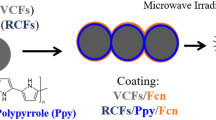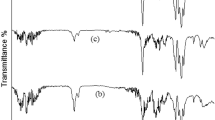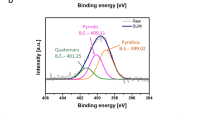Abstract
Composites made with engineered nanomaterials (nanocomposites) have a wide range of applications, from use in basic consumer goods to critical national defense technologies. Carbon nanotubes (CNTs) are a popular addition in nanocomposites because of their enhanced mechanical, thermal, and electrical properties. Concerns have been raised, though, regarding potential exposure and health risks from nanocomposites containing CNTs because of comparisons to other high aspect ratio fibers. Assessing the factors affecting CNT release from composites is therefore paramount for understanding potential exposure scenarios that may occur during product handling and manipulation. Standardized methods for detecting and quantifying released CNTs, however, have not yet been developed. We therefore evaluated experimental approaches deployed by various researchers, with an emphasis on characterizing free versus composite bound CNTs. From our analysis of published studies characterizing CNT releases from nanocomposites, we found that the qualitative and quantitative methods used across studies varied greatly, thus limiting the ability for objective comparison and evaluation of various release factors. Nonetheless, qualitative results indicated that factors such as composite type, CNT functionalization, and energy input during manipulation (i.e., grinding) may affect CNT release. Based on our findings, we offer several recommendations for future product testing and assessment of potential exposure and health risks associated with CNT nanocomposites.
This is a preview of subscription content, access via your institution
Access options
Subscribe to this journal
Receive 6 print issues and online access
$259.00 per year
only $43.17 per issue
Buy this article
- Purchase on Springer Link
- Instant access to full article PDF
Prices may be subject to local taxes which are calculated during checkout
Similar content being viewed by others
References
Ibeh CC, Hui D, Shivakumar K . Literature survey of current state of research on nanocomposites and multifunctional materials. Office of Naval Research (ONR). 2006.
Ma P-C, Siddiqui NA, Marom G, Kim J-K . Dispersion and functionalization of carbon nanotubes for polymer-based nanocomposites: A review. Composites Part A: Applied Science and Manufacturing 2010; 41: 1345–1367.
De Volder MF, Tawfick SH, Baughman RH, Hart AJ . Carbon nanotubes: present and future commercial applications. science 2013; 339: 535–539.
Methner M, Crawford C, Geraci C . Evaluation of the potential airborne release of carbon nanofibers during the preparation, grinding, and cutting of epoxy-based nanocomposite material. J Occup Environ Hyg 2012; 9: 308–318.
Bello D, Wardle B, Yamamoto N, Guzman deVilloria R, Garcia E, Hart A et al. Exposure to nanoscale particles and fibers during machining of hybrid advanced composites containing carbon nanotubes. J Nanopart Res 2009; 11: 231–249.
Poland CA, Duffin R, Kinloch I, Maynard A, Wallace WA, Seaton A et al. Carbon nanotubes introduced into the abdominal cavity of mice show asbestos-like pathogenicity in a pilot study. Nature nanotechnology 2008; 3: 423–428.
Fries R, Grebler S, Simko M Carbon nanotubes - Part II: Risks and regulations. Institute of Technology Assessment of the Austrian Academy of Sciences 2012.
Golanski L, Guiot A, Pras M, Malarde M, Tardif F . Release-ability of nano fillers from different nanomaterials (toward the acceptability of nanoproduct). J Nanopart Res 2012; 14: 1–9.
Wohlleben W, Meier MW, Vogel S, Landsiedel R, Cox G, Hirth S et al. Elastic CNT-polyurethane nanocomposite: synthesis, performance and assessment of fragments released during use. Nanoscale 2013; 5: 369–380.
Wohlleben W, Brill S, Meier MW, Mertler M, Cox G, Hirth S et al. On the Lifecycle of Nanocomposites: Comparing Released Fragments and their In Vivo Hazards from Three Release Mechanisms and Four Nanocomposites. Small 2011; 7: 2384–2395.
Schlagenhauf L, Chu BT, Buha J, Nuesch F, Wang J . Release of carbon nanotubes from an epoxy-based nanocomposite during an abrasion process. Environ Sci Technol 2012; 46: 7366–7372.
Huang G, Park JH, Cena LG, Shelton BL, Peters TM . Evaluation of Airborne Particle Emissions from Commercial Products Containing Carbon Nanotubes. J Nanopart Res 2012; 14: 1–13.
Gomez V, Levin M, Saber AT, Irusta S, Dal Maso M, Hanoi R et al. Comparison of Dust Release from Epoxy and Paint Nanocomposites and Conventional Products during Sanding and Sawing. Ann Occup Hyg 2014; 58: 983–994.
Cena LG, Peters TM . Characterization and Control of Airborne Particles Emitted During Production of Epoxy/Carbon Nanotube Nanocomposites. Journal of Occupational and Environmental Hygiene 2011; 8: 86–92.
Bello D, Wardle BL, Zhang J, Yamamoto N, Santeufemio C, Hallock M et al. Characterization of exposures to nanoscale particles and fibers during solid core drilling of hybrid carbon nanotube advanced composites. Int J Occup Environ Health 2010; 16: 434–450.
Bouillard J, R’Mili B, Moranviller D, Vignes A, Le Bihan O, Ustache A et al. Nanosafety by design: risks from nanocomposite/nanowaste combustion. J Nanopart Res 2013; 15: 1–11.
Uddin N, Nyden M, Davis R. Characterization of Nanoparticle Release from Polymer Nanocomposites Due to Fire. In: Nanotech 2011 Conference and Expo. Boston, MA, 2011.
Jiang L, Kondo A, Shigeta M, Endoh S, Uejima M, Ogura I et al. Evaluation of Particles Released from Single-wall Carbon Nanotube/Polymer Composites with or Without Thermal Aging by an Accelerated Abrasion Test. J Occup Environ Hyg 2014; 11: 658–664.
Hirth S, Cena L, Cox G, Tomovic Z, Peters T, Wohlleben W . Scenarios and methods that induce protruding or released CNTs after degradation of nanocomposite materials. J Nanopart Res 2013; 15: 1504.
Nguyen T, Pellegrin B, Bernard C, Gu X, Gorham JM, Stutzman P et al. Fate of nanoparticles during life cycle of polymer nanocomposites. Journal of Physics. Conference Series 2011; 304: 012060.
Boonruksa P, Bello D, Zhang J, Isaacs JA, Mead JL, Woskie SR . Characterization of Potential Exposures to Nanoparticles and Fibers during Manufacturing and Recycling of Carbon Nanotube Reinforced Polypropylene Composites. Annals of Occupational Hygiene 2016; 60: 40–55.
Heitbrink WA, Lo L-M . Effect of carbon nanotubes upon emissions from cutting and sanding carbon fiber-epoxy composites. J Nanopart Res 2015; 17: 1–17.
Methner MM, Birch ME, Evans DE, Ku BK, Crouch K, Hoover MD . Identification and characterization of potential sources of worker exposure to carbon nanofibers during polymer composite laboratory operations. J Occup Environ Hyg 2007; 4: D125–D130.
Schlagenhauf L, Kianfar B, Buerki-Thurnherr T, Kuo YY, Wichser A, Nuesch F et al. Weathering of a carbon nanotube/epoxy nanocomposite under UV light and in water bath: impact on abraded particles. Nanoscale 2015; 7: 18524–18536.
Thompson D, Chen S-C, Wang J, Pui DY . Aerosol Emission Monitoring and Assessment of Potential Exposure to Multi-walled Carbon Nanotubes in the Manufacture of Polymer Nanocomposites. Annals of Occupational Hygiene 2015; 59: 1135–1151.
Schlagenhauf L, Kuo Y-Y, Bahk YK, Nüesch F, Wang J . Decomposition and particle release of a carbon nanotube/epoxy nanocomposite at elevated temperatures. J Nanopart Res 2015; 17: 1–11.
Heitbrink WA, Lo L-M, Dunn KH . Exposure Controls for Nanomaterials at Three Manufacturing Sites. Journal of Occupational and Environmental Hygiene 2015; 12: 16–28.
Fonseca AS, Viitanen A-K, Koivisto AJ, Kangas A, Huhtiniemi M, Hussein T et al. Characterization of Exposure to Carbon Nanotubes in an Industrial Setting. Annals of Occupational Hygiene 2014; 59: 586–599.
Ji JH, Kim JB, Lee G, Bae G-N . Nanomaterial release characteristics in a single-walled carbon nanotube manufacturing workplace. J Nanopart Res 2015; 17: 1–18.
Dahm MM, Schubauer-Berigan MK, Evans DE, Birch ME, Fernback JE, Deddens JA . Carbon Nanotube and Nanofiber Exposure Assessments: An Analysis of 14 Site Visits. Annals of Occupational Hygiene 2015; 59: 705–723.
Maynard AD, Baron PA, Foley M, Shvedova AA, Kisin ER, Castranova V . Exposure to carbon nanotube material: aerosol release during the handling of unrefined single-walled carbon nanotube material. Journal of Toxicology and Environmental Health, Part A 2004; 67: 87–107.
Willeke K, Baron PA . Aerosol measurement: principles, techniques and applications 1993.
Kulkarni P, Baron PA, Willeke K . Aerosol measurement: principles, techniques, and applications. John Wiley & Sons. 2011.
Hinds WC . Aerosol technology: properties, behavior, and measurement of airborne particles 1999.
NIOSH. CURRENT INTELLIGENCE BULLETIN 65:Occupational Exposure to Carbon Nanotubes and Nanofibers. In 2013.
Madl AK, Pinkerton KE . Health effects of inhaled engineered and incidental nanoparticles. Crit Rev Toxicol 2009; 39: 629–658.
Oberdörster G . Pulmonary effects of inhaled ultrafine particles. International archives of occupational and environmental health 2000; 74: 1–8.
Oberdörster G, Oberdörster E, Oberdörster J . Nanotoxicology: An Emerging Discipline Evolving from Studies of Ultrafine Particles. Environmental Health Perspectives 2005; 113: 823–839.
Sager TM, Castranova V . Surface area of particle administered versus mass in determining the pulmonary toxicity of ultrafine and fine carbon black: comparison to ultrafine titanium dioxide. Part Fibre Toxicol 2009; 6: 15.
Ku BK, Maynard AD, Baron PA, Deye GJ . Observation and measurement of anomalous responses in a differential mobility analyzer caused by ultrafine fibrous carbon aerosols. Journal of Electrostatics 2007; 65: 542–548.
Kulkarni P, Deye GJ, Baron PA . Bipolar diffusion charging characteristics of single-wall carbon nanotube aerosol particles. Journal of Aerosol Science 2009; 40: 164–179.
Donaldson K, Aitken R, Tran L, Stone V, Duffin R, Forrest G et al. Carbon Nanotubes: A Review of Their Properties in Relation to Pulmonary Toxicology and Workplace Safety. Toxicological Sciences 2006; 92: 5–22.
ISO. International Organization for Standardization. Ambient air - determination of asbestos fibres - direct transfer transmission electron microscopy method ISO 10312 1995.
Kreider ML, Cyrs WD, Tosiano MA, Panko JM . Evaluation of Quantitative Exposure Assessment Method for Nanomaterials in Mixed Dust Environments: Application in Tire Manufacturing Facilities. Ann Occup Hyg 2015; 59: 1122–1134.
Schlagenhauf L, Bürki-Thurnherr T, Kuo Y-Y, Wichser A, Nüesch FA, Wick P et al. Carbon Nanotubes Released from an Epoxy-Based Nanocomposite: Quantification and Particle Toxicity. Environmental Science & Technology 2015; 49: 10616–10623.
Wang X, Xia T, Duch MC, Ji Z, Zhang H, Li R et al. Pluronic F108 coating decreases the lung fibrosis potential of multiwall carbon nanotubes by reducing lysosomal injury. Nano Lett 2012; 12: 3050–3061.
Methner M, Hodson L, Dames A, Geraci C . Nanoparticle emission assessment technique (NEAT) for the identification and measurement of potential inhalation exposure to engineered nanomaterials—Part B: Results from 12 field studies. Journal of Occupational and Environmental Hygiene 2010; 7: 163–176.
Methner M, Hodson L, Geraci C . Nanoparticle emission assessment technique (NEAT) for the identification and measurement of potential inhalation exposure to engineered nanomaterials—Part A. Journal of Occupational and Environmental Hygiene 2010; 7: 127–132.
Kumar AP, Depan D, Singh Tomer N, Singh RP . Nanoscale particles for polymer degradation and stabilization—Trends and future perspectives. Progress in Polymer Science 2009; 34: 479–515.
Grosse Y, Loomis D, Guyton KZ, Lauby-Secretan B, El Ghissassi F, Bouvard V et al. Carcinogenicity of fluoro-edenite, silicon carbide fibres and whiskers, and carbon nanotubes. The Lancet Oncology 2014; 15: 1427–1428.
Johnston HJ, Hutchison GR, Christensen FM, Peters S, Hankin S, Aschberger K et al. A critical review of the biological mechanisms underlying the in vivo and in vitro toxicity of carbon nanotubes: The contribution of physico-chemical characteristics. Nanotoxicology 2010; 4: 207–246.
Hamilton RF, Jr, Buford M, Xiang C, Wu N, Holian A . NLRP3 inflammasome activation in murine alveolar macrophages and related lung pathology is associated with MWCNT nickel contamination. Inhalation toxicology 2012; 24: 995–1008.
Jain S, Thakare VS, Das M, Godugu C, Jain AK, Mathur R et al. Toxicity of multiwalled carbon nanotubes with end defects critically depends on their functionalization density. Chemical research in toxicology 2011; 24: 2028–2039.
Murphy FA, Poland CA, Duffin R, Al-Jamal KT, Ali-Boucetta H, Nunes A et al. Length-dependent retention of carbon nanotubes in the pleural space of mice initiates sustained inflammation and progressive fibrosis on the parietal pleura. The American journal of pathology 2011; 178: 2587–2600.
Oberdorster G, Castranova V, Asgharian B, Sayre P . Inhalation Exposure to Carbon Nanotubes (CNT) and Carbon Nanofibers (CNF): Methodology and Dosimetry. J Toxicol Environ Health B. Crit Rev 2015; 18: 121–212.
Wang X, Sun B, Liu S, Xia T . Structure activity relationships of engineered nanomaterials in inducing NLRP3 inflammasome activation and chronic lung fibrosis. NanoImpact 2017; 6: 99–108.
Saber AT, Mortensen A, Szarek J, Koponen IK, Levin M, Jacobsen NR et al. Epoxy composite dusts with and without carbon nanotubes cause similar pulmonary responses, but differences in liver histology in mice following pulmonary deposition. Part Fibre Toxicol 2016; 13: 37.
Ma-Hock L, Treumann S, Strauss V, Brill S, Luizi F, Mertler M et al. Inhalation Toxicity of Multiwall Carbon Nanotubes in Rats Exposed for 3 Months. Toxicological Sciences 2009; 112: 468–481.
Pauluhn J . Subchronic 13-Week Inhalation Exposure of Rats to Multiwalled Carbon Nanotubes: Toxic Effects Are Determined by Density of Agglomerate Structures, Not Fibrillar Structures. Toxicological Sciences 2010; 113: 226–242.
Pauluhn J . Multi-walled carbon nanotubes (Baytubes): approach for derivation of occupational exposure limit. Regul Toxicol Pharmacol 2010; 57: 78–89.
Author information
Authors and Affiliations
Corresponding author
Ethics declarations
Competing interests
The authors declare no conflict of interest.
Rights and permissions
About this article
Cite this article
Kovochich, M., Fung, CC., Avanasi, R. et al. Review of techniques and studies characterizing the release of carbon nanotubes from nanocomposites: Implications for exposure and human health risk assessment. J Expo Sci Environ Epidemiol 28, 203–215 (2018). https://doi.org/10.1038/jes.2017.6
Received:
Accepted:
Published:
Issue Date:
DOI: https://doi.org/10.1038/jes.2017.6
Keywords
This article is cited by
-
A review on the fate and transport behavior of engineered nanoparticles: possibility of becoming an emerging contaminant in the groundwater
International Journal of Environmental Science and Technology (2023)
-
Health Risk Assessment for Human Exposure to Trace Metals and Arsenic via Consumption of Hen Egg Collected from Largest Poultry Industry in Iran
Biological Trace Element Research (2019)



